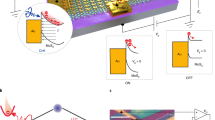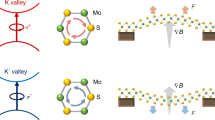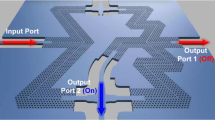Abstract
Valleytronics is a promising candidate to address low-energy signal transport on chip, leveraging the valley pseudospin of electrons as a new degree of freedom to encode, process and store information1,2,3,4,5,6,7. However, valley-carrier nanocircuitry is still elusive, because it essentially requires valley transport that overcomes three simultaneous challenges: high fidelity, high directionality and room-temperature operation. Here we experimentally demonstrate a nanophotonic circuit that can route valley indices of a WS2 monolayer unidirectionally via the chirality of photons. Two propagating modes are supported in the gap area of the circuit and interfere with each other to generate beating patterns, which exhibit complementary profiles for circular dipoles of different handedness. Based on the spin-dependent beating patterns, we showcase valley fidelity of chiral photons up to 98%, and the circulation directionality is measured to be 0.44 ± 0.04 at room temperature. The proposed nanocircuit can not only enable the construction of large-scale valleytronic networks but also serve as an interactive interface to integrate valleytronics3,4,5, spintronics8,9,10 and integrated photonics11,12,13, opening new possibilities for hybrid spin-valley-photon ecosystems at the nanoscale.
This is a preview of subscription content, access via your institution
Access options
Access Nature and 54 other Nature Portfolio journals
Get Nature+, our best-value online-access subscription
$29.99 / 30 days
cancel any time
Subscribe to this journal
Receive 12 print issues and online access
$259.00 per year
only $21.58 per issue
Buy this article
- Purchase on Springer Link
- Instant access to full article PDF
Prices may be subject to local taxes which are calculated during checkout




Similar content being viewed by others
Data availability
The raw data underlying the graphs of this paper are available via Figshare at https://figshare.com/articles/dataset/RAW_data_for_NNANO-22061298A.rar/20515695. Further data that support the findings of this study are available from the corresponding authors upon reasonable request.
References
Mak, K. F., McGill, K. L., Park, J. & McEuen, P. L. The valley Hall effect in MoS2 transistors. Science 344, 1489–1492 (2014).
Lee, J., Mak, K. F. & Shan, J. Electrical control of the valley Hall effect in bilayer MoS2 transistors. Nat. Nanotechnol. 11, 421–425 (2016).
Schaibley, J. R. et al. Valleytronics in 2D materials. Nat. Rev. Mater. 1, 16055 (2016).
Vitale, S. A. et al. Valleytronics: opportunities, challenges, and paths forward. Small 14, 1801483 (2018).
Wang, G. et al. Colloquium: Excitons in atomically thin transition metal dichalcogenides. Rev. Mod. Phys. 90, 021001 (2018).
Lundt, N. et al. Optical valley Hall effect for highly valley-coherent exciton-polaritons in an atomically thin semiconductor. Nat. Nanotechnol. 14, 770–775 (2019).
Ciarrocchi, A., Tagarelli, F., Avsar, A. & Kis, A. Excitonic devices with van der Waals heterostructures: valleytronics meets twistronics. Nat. Rev. Mater. https://doi.org/10.1038/s41578-41021-00408-41577 (2022).
Wolf, S. et al. Spintronics: a spin-based electronics vision for the future. Science 294, 1488–1495 (2001).
Bhatti, S. et al. Spintronics based random access memory: a review. Mater. Today 20, 530–548 (2017).
Bonilla, M. et al. Strong room-temperature ferromagnetism in VSe2 monolayers on van der Waals substrates. Nat. Nanotechnol. 13, 289–293 (2018).
Chen, Z. & Segev, M. Highlighting photonics: looking into the next decade. eLight 1, 1–12 (2021).
Levy, J. S. et al. CMOS-compatible multiple-wavelength oscillator for on-chip optical interconnects. Nat. Photonics 4, 37–40 (2010).
Cheben, P., Halir, R., Schmid, J. H., Atwater, H. A. & Smith, D. R. Subwavelength integrated photonics. Nature 560, 565–572 (2018).
Fleury, R., Sounas, D. L., Sieck, C. F., Haberman, M. R. & Alu, A. Sound isolation and giant linear nonreciprocity in a compact acoustic circulator. Science 343, 516–519 (2014).
Barzanjeh, S. et al. Mechanical on-chip microwave circulator. Nat. Commun. 8, 953 (2017).
Scheucher, M., Hilico, A., Will, E., Volz, J. & Rauschenbeutel, A. Quantum optical circulator controlled by a single chirally coupled atom. Science 354, 1577–1580 (2016).
Nagulu, A., Reiskarimian, N. & Krishnaswamy, H. Non-reciprocal electronics based on temporal modulation. Nat. Electron. 3, 241–250 (2020).
Lee, D. et al. Hyperbolic metamaterials: fusing artificial structures to natural 2D materials. eLight 2, 1–23 (2022).
Chen, P. et al. Chiral coupling of valley excitons and light through photonic spin–orbit interactions. Adv. Opt. Mater. 8, 1901233 (2020).
Chen, Y. et al. Multidimensional nanoscopic chiroptics. Nat. Rev. Phys. 4, 113–124 (2021).
Gong, S. H., Alpeggiani, F., Sciacca, B., Garnett, E. C. & Kuipers, L. Nanoscale chiral valley-photon interface through optical spin-orbit coupling. Science 359, 443–447 (2018).
Chervy, T. et al. Room temperature chiral coupling of valley excitons with spin-momentum locked surface plasmons. ACS Photonics 5, 1281–1287 (2018).
Sun, L. et al. Separation of valley excitons in a MoS2 monolayer using a subwavelength asymmetric groove array. Nat. Photonics 13, 180–184 (2019).
Gong, S.-H., Komen, I., Alpeggiani, F. & Kuipers, L. Nanoscale optical addressing of valley pseudospins through transverse optical spin. Nano Lett. 20, 4410–4415 (2020).
Chen, P.-G. et al. Long-range directional routing and spatial selection of high-spin-purity valley trion emission in monolayer WS2. ACS Nano 15, 18163–18171 (2021).
Zeng, H., Dai, J., Yao, W., Xiao, D. & Cui, X. Valley polarization in MoS2 monolayers by optical pumping. Nat. Nanotechnol. 7, 490–493 (2012).
Mak, K. F., He, K., Shan, J. & Heinz, T. F. Control of valley polarization in monolayer MoS2 by optical helicity. Nat. Nanotechnol. 7, 494–498 (2012).
Cao, T. et al. Valley-selective circular dichroism of monolayer molybdenum disulphide. Nat. Commun. 3, 887 (2012).
Xiao, J. et al. Nonlinear optical selection rule based on valley-exciton locking in monolayer ws2. Light Sci. Appl. 4, e366–e366 (2015).
Luo, Y. et al. Deterministic coupling of site-controlled quantum emitters in monolayer WSe2 to plasmonic nanocavities. Nat. Nanotechnol. 13, 1137–1142 (2018).
Wu, Z., Li, J., Zhang, X., Redwing, J. M. & Zheng, Y. Room-temperature active modulation of valley dynamics in a monolayer semiconductor through chiral Purcell effects. Adv. Mater. 31, e1904132 (2019).
Oulton, R. F., Sorger, V. J., Genov, D. A., Pile, D. F. P. & Zhang, X. A hybrid plasmonic waveguide for subwavelength confinement and long-range propagation. Nat. Photonics 2, 496–500 (2008).
Palik, E.D. Handbook of Optical Constants of Solids Vol. 3 (Academic Press, 1998).
Acknowledgements
Y.C. acknowledges support from the start-up funding of the University of Science and Technology of China and the CAS Talents Program. This work was supported by the National Natural Science Foundation of China (Nos. 12021004, 91850113, 11774115 and 11904271) and the Basic and Applied Basic Research Major Program of Guangdong Province (No. 2019B030302003). We thank the Center of Nano-Science and Technology of Wuhan University for their support in sample fabrication. This work was partially carried out at the USTC Center for Micro and Nanoscale Research and Fabrication. D.W. acknowledges support from the National Natural Science Foundation of China (No. 61927814). A.A. acknowledges financial support from the Air Force Office of Scientific Research with MURI grant no. FA9550-18-1-0379 and the Simons Foundation. C.-W.Q. acknowledges financial support from the National Research Foundation, Prime Minister’s Office, Singapore under Competitive Research Program Award NRF-CRP22-2019-0006. C.-W.Q. is also supported by a grant (A-0005947-16-00) from the Advanced Research and Technology Innovation Centre (ARTIC).
Author information
Authors and Affiliations
Contributions
Y.C. and C.-W.Q. conceived the idea and designed the experiments. K.W., P.L. and C.-W.Q. supervised the project. Y.C. conducted the simulations and theoretical analysis. S.Q., X.X and K.W. performed the experiments. Y.C., K.W., and C.-W.Q analysed the data. Y.C. drafted the paper with input from all authors.
Corresponding authors
Ethics declarations
Competing interests
The authors declare no competing interests.
Peer review
Peer review information
Nature Nanotechnology thanks Jorge Quereda and Xiaomu Wang for their contribution to the peer review of this work.
Additional information
Publisher’s note Springer Nature remains neutral with regard to jurisdictional claims in published maps and institutional affiliations.
Supplementary information
Supplementary Information
Supplementary Sections 1–9.
Supplementary Video 1
The encoding, transport and decoding of the word ‘LOVE’ by the valley-preserved nanocircuit.
Rights and permissions
Springer Nature or its licensor holds exclusive rights to this article under a publishing agreement with the author(s) or other rightsholder(s); author self-archiving of the accepted manuscript version of this article is solely governed by the terms of such publishing agreement and applicable law.
About this article
Cite this article
Chen, Y., Qian, S., Wang, K. et al. Chirality-dependent unidirectional routing of WS2 valley photons in a nanocircuit. Nat. Nanotechnol. 17, 1178–1182 (2022). https://doi.org/10.1038/s41565-022-01217-x
Received:
Accepted:
Published:
Issue Date:
DOI: https://doi.org/10.1038/s41565-022-01217-x
This article is cited by
-
Coherent control of enhanced second-harmonic generation in a plasmonic nanocircuit using a transition metal dichalcogenide monolayer
Nature Communications (2024)
-
Recent progress of exciton transport in two-dimensional semiconductors
Nano Convergence (2023)
-
Photonic van der Waals integration from 2D materials to 3D nanomembranes
Nature Reviews Materials (2023)
-
Versatile optical manipulation of trions, dark excitons and biexcitons through contrasting exciton-photon coupling
Light: Science & Applications (2023)



